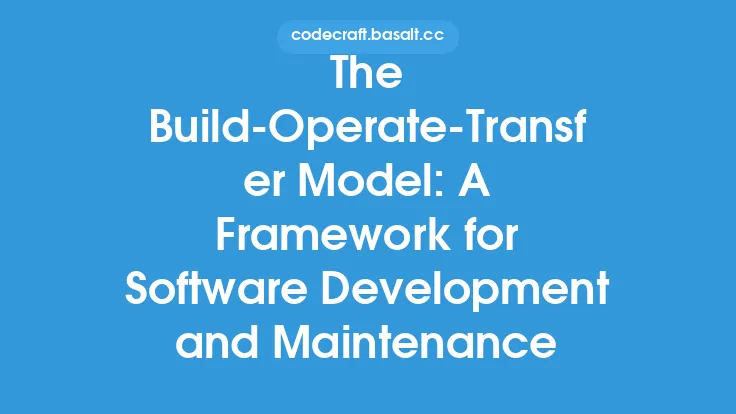Adaptive Software Development (ASD) is a framework for managing agile projects, focusing on iterative and incremental delivery of software products. Developed by Jim Highsmith, ASD emphasizes collaboration, continuous improvement, and adaptability in response to changing project requirements. This approach recognizes that software development is a complex and dynamic process, requiring flexibility and responsiveness to deliver high-quality products.
Key Principles of Adaptive Software Development
The core principles of ASD include collaborative work, iterative development, and continuous learning. The framework encourages teams to work together, sharing knowledge and expertise to deliver software products that meet customer needs. Iterative development involves breaking down the project into smaller, manageable chunks, with each iteration building on the previous one. Continuous learning is also essential, as teams reflect on their experiences and adapt their approach to improve future iterations.
Components of Adaptive Software Development
ASD consists of several key components, including project initiation, iterative development, and project closure. During project initiation, the team defines the project scope, goals, and deliverables. The iterative development phase involves a series of cycles, each consisting of specification, development, and testing. Project closure occurs when the final product is delivered, and the team conducts a retrospective to identify lessons learned and areas for improvement.
Iterative Development Cycle
The iterative development cycle is the heart of ASD, where the team works together to deliver a working software product. Each cycle consists of three phases: specification, development, and testing. During the specification phase, the team defines the requirements and scope for the current iteration. The development phase involves designing, coding, and integrating the software components. Testing and validation occur during the testing phase, ensuring that the software meets the specified requirements.
Roles and Responsibilities in Adaptive Software Development
ASD defines several roles and responsibilities, including the customer, project manager, and development team. The customer is responsible for providing input and feedback on the software product, ensuring that it meets their needs and expectations. The project manager oversees the project, coordinating the team's efforts and ensuring that the project is delivered on time and within budget. The development team consists of cross-functional members, including developers, testers, and designers, who work together to deliver the software product.
Adaptive Software Development Life Cycle
The ASD life cycle consists of five phases: inception, iteration, construction, transition, and retirement. During the inception phase, the team defines the project scope and goals. The iteration phase involves a series of iterative development cycles, each delivering a working software product. The construction phase focuses on building the software product, with the team working together to integrate the various components. The transition phase occurs when the final product is delivered, and the team ensures a smooth handover to the customer. The retirement phase involves decommissioning the software product, ensuring that it is properly archived and documented.
Benefits of Adaptive Software Development
ASD offers several benefits, including improved collaboration, increased flexibility, and enhanced customer satisfaction. By working together, teams can share knowledge and expertise, reducing the risk of errors and improving overall quality. The iterative and incremental approach allows for flexibility and adaptability, enabling teams to respond quickly to changing project requirements. ASD also emphasizes customer involvement, ensuring that the software product meets their needs and expectations.
Challenges and Limitations of Adaptive Software Development
While ASD offers several benefits, it also presents some challenges and limitations. One of the main challenges is the need for effective communication and collaboration among team members. ASD requires a high degree of flexibility and adaptability, which can be difficult to achieve in traditional or bureaucratic organizations. Additionally, the iterative and incremental approach can lead to scope creep, where the project scope expands beyond the original boundaries.
Best Practices for Implementing Adaptive Software Development
To implement ASD successfully, teams should follow several best practices, including collaborative work, continuous learning, and iterative development. Teams should work together, sharing knowledge and expertise to deliver high-quality software products. Continuous learning is essential, as teams reflect on their experiences and adapt their approach to improve future iterations. Iterative development involves breaking down the project into smaller, manageable chunks, with each iteration building on the previous one.
Tools and Techniques for Adaptive Software Development
Several tools and techniques support ASD, including agile project management tools, version control systems, and continuous integration and deployment (CI/CD) pipelines. Agile project management tools, such as Jira or Trello, help teams manage and track their work, ensuring that everyone is aligned and working towards the same goals. Version control systems, such as Git, enable teams to manage changes to the software codebase, ensuring that all changes are tracked and reversible. CI/CD pipelines automate the build, test, and deployment process, ensuring that the software product is delivered quickly and reliably.
Conclusion
Adaptive Software Development (ASD) is a framework for managing agile projects, focusing on iterative and incremental delivery of software products. By emphasizing collaboration, continuous improvement, and adaptability, ASD enables teams to deliver high-quality software products that meet customer needs and expectations. While ASD presents some challenges and limitations, its benefits, including improved collaboration, increased flexibility, and enhanced customer satisfaction, make it a popular choice for software development teams. By following best practices, using the right tools and techniques, and embracing the core principles of ASD, teams can successfully implement this framework and achieve their project goals.





